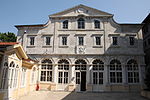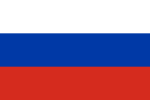The Slavs or Slavic people are a group of peoples who speak Slavic languages. Slavs are geographically distributed throughout the northern parts of Eurasia;... 98 KB (8,444 words) - 12:26, 24 April 2024 |
 | List of early Slavic peoples (section East Slavs) (Proto-Indo-European speakers) Proto-Balto-Slavs (common ancestors of Balts and Slavs) (Proto-Balto-Slavic speakers) Proto-Slavs (Proto-Slavic speakers) Sporoi (also... 44 KB (4,613 words) - 18:38, 16 March 2024 |
 | Old East Slavic (traditionally also Old Russian) was a language (or a group of dialects) used by the East Slavs from the 7th or 8th century to the 13th... 49 KB (4,811 words) - 12:03, 21 April 2024 |
 | the monarchs of the South Slavs adopted Christianity in the 9th century, the East Slavs in the 10th, and the West Slavs between the 9th and 12th century... 10 KB (946 words) - 04:58, 8 August 2023 |
Slavs, the ancestors of the Slavs (the subsequent ethnic group name). Thus, the Slav ethnonym at first denoted the southern group of the early Slavs.... 26 KB (2,591 words) - 01:33, 16 March 2024 |
 | Svarozhits (section East Slavs) suggested that Svarog may be a borrowing from Indo-Aryan languages, but the Slavs and Indo-Aryans were separated by too much space for them to have direct... 18 KB (2,200 words) - 07:48, 18 January 2024 |
 | formerly used in Eastern and Central Europe as common ethnonyms for East Slavs, particularly during the late medieval and early modern periods. The Latin... 43 KB (4,558 words) - 20:18, 27 April 2024 |
 | Sclaveni (redirect from Early South Slavs) an Avar embassy requesting his Slavs to accept Avar suzerainty and pay tribute, because the Avars knew that the Slavs had amassed great wealth after repeatedly... 32 KB (4,105 words) - 10:59, 5 March 2024 |
 | Polabian Slavs, also known as Elbe Slavs and more broadly as Wends, is a collective term applied to a number of Lechitic (West Slavic) tribes who lived... 23 KB (2,656 words) - 11:43, 16 April 2024 |
 | List of Slavic pseudo-deities (section East Slavs) deemed actually to have been objects of worship among pagan Slavs. The pseudo-deities of the Slavs, like those of other ethnic groups, were created as a result... 25 KB (2,589 words) - 01:17, 18 December 2023 |
 | the South Slavs for centuries. These were mainly the Byzantine Empire, Austria-Hungary, the Ottoman Empire, and Venice. Extensive pan-Slavism began much... 36 KB (4,145 words) - 14:39, 5 April 2024 |
The pagan Slavs were polytheistic, which means that they worshipped many gods and goddesses. The gods of the Slavs are known primarily from a small number... 34 KB (2,181 words) - 17:37, 20 April 2024 |
 | of the conversion of the Bulgarians facilitated the conversion of the East Slavs.[failed verification] A major event in this effort was the development... 212 KB (22,213 words) - 16:10, 28 April 2024 |
Vistula Veneti (redirect from Veneti (Slavs)) most likely locus of the ethnogenesis of Slavs. According to Polish archaeologist Michał Parczewski, Slavs began to settle in southeastern Poland no... 18 KB (2,480 words) - 04:54, 19 March 2024 |
 | Donkeyskin (section East Slavs) Tale type ATU 510B also exists in the repertoire of the East Slavs. According to the East Slavic Folktale Catalogue (Russian: СУС, romanized: SUS),... 31 KB (4,569 words) - 15:59, 14 April 2024 |
Early East Slavs settled the forested hills of today's Minsk by the 9th century. They had been migrating from further south and pushing the preceding Balts... 26 KB (3,476 words) - 17:59, 11 April 2023 |
Slavs, a subgroup of Slavic peoples who speak the East Slavic languages Old East Slavic, a language used during the 10th–15th centuries by East Slavs... 396 bytes (84 words) - 15:15, 15 April 2020 |
 | Russians (category East Slavs) Genetically, East Slavs are quite similar to West Slavs; such genetic similarity is somewhat unusual for genetics with such a wide settlement of the Slavs, especially... 123 KB (10,308 words) - 08:01, 9 April 2024 |
 | Drevlians (category East Slavic tribes) of Medieval Slavic tribes "Slavs". Encyclopedia of Ukraine. 1993. Retrieved 2023-01-25. Francis Conte (1995). The Slavs. East European Monographs. p. 71... 6 KB (663 words) - 06:27, 14 February 2024 |
 | Polotsk or Polotskian Rus', was a medieval principality of the Early East Slavs. The origin and date of state establishment is uncertain. Chronicles of... 13 KB (1,356 words) - 17:03, 6 April 2024 |
cultures of Slavic Europe. East Slavs: Culture of Belarus Culture of Russia Culture of Kievan Rus' Culture of Ukraine South Slavs: Culture of Bosnia and Herzegovina... 868 bytes (87 words) - 15:54, 23 January 2024 |
 | Kievan Rus' (category Articles containing Old East Slavic-language text) the Rus' were themselves Slavs (see Anti-Normanism). Normanist theories focus on the earliest written source for the East Slavs, the Primary Chronicle,[failed... 116 KB (12,514 words) - 06:17, 27 April 2024 |
George's Day in Spring (category Folk calendar of the East Slavs) George's Day in Spring, or Saint George's Day (Serbian: Ђурђевдан, romanized: Đurđevdan, pronounced [ˈdʑûːrdʑeʋdaːn]; Bulgarian: Гергьовден, romanized: Gergyovden;... 14 KB (1,695 words) - 17:03, 15 April 2024 |
 | Ukrainians (category East Slavs) largest diasporas in the world.[citation needed] The East Slavs emerged from the undifferentiated early Slavs in the Slavic migrations of the 6th and 7th centuries... 114 KB (9,094 words) - 13:54, 12 April 2024 |






